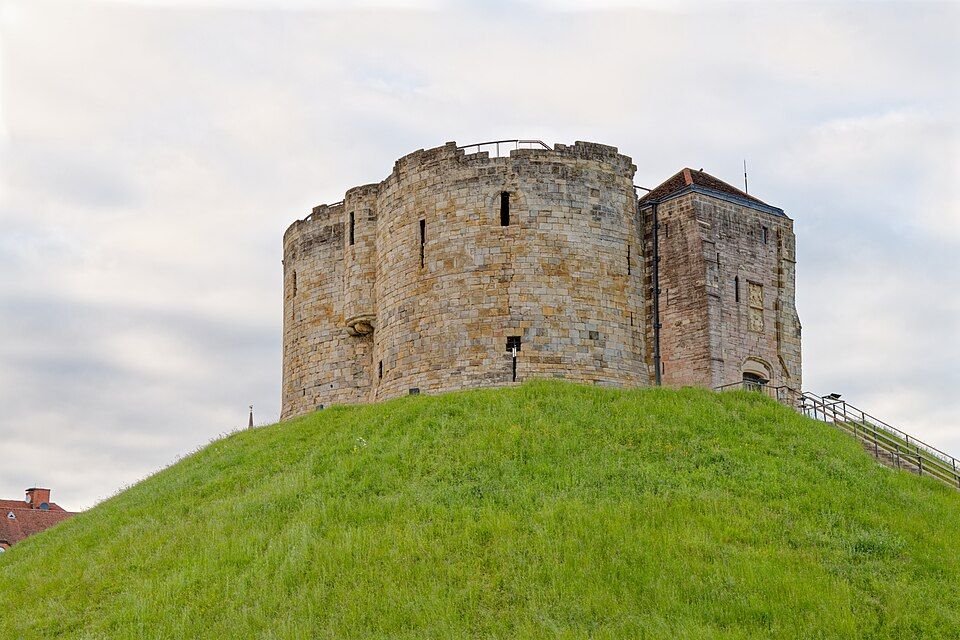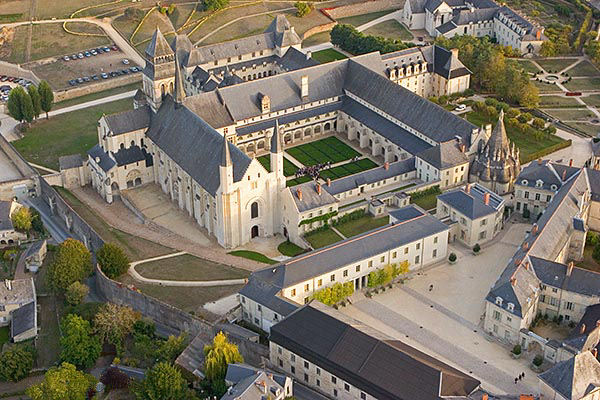IB Syllabus focus:
'The social atmosphere of Richard's reign, including the treatment of various religious and ethnic groups, particularly Jews and Muslims.
Cultural contributions and patronage associated with Richard's court and his wider empire.
The religious dimensions of his reign, including his role in the Crusades and his patronage of religious houses.'
Richard I's era witnessed profound shifts in societal perspectives, evolving cultural landscapes, and multifaceted religious engagements, influencing the essence of medieval European society.
Social Atmosphere
Treatment of Jews
Rise in Anti-Semitism: The period marked by Richard's ascent saw a surge in anti-Semitic sentiments. This hostility was manifested in various events across England.
Massacre at York (1190): One of the darkest episodes was the massacre at York, where numerous Jews sought refuge in the castle to escape mob violence but eventually met tragic ends.

Clifford’s Tower—stone keep of York Castle—overlooks the site where members of York’s Jewish community were besieged and killed in March 1190. The image situates the social tensions and anti-Jewish violence of Richard I’s reign in a concrete setting. Source
Reasons for Animosity: The underlying factors for such animosities ranged from economic grievances—owing to the Jews' role in moneylending—to deep-rooted religious prejudices.
King's Stance: Contrary to the widespread hatred, Richard did not personally endorse violence against the Jews. He recognised their economic significance and took punitive measures against those instigating violence.
Treatment of Muslims
Context of the Crusades: The era's lens towards Muslims was primarily through the prism of the Crusades, which propagated a distinct Christian-Muslim rivalry.
Respect Amidst Hostilities: Despite the overarching antagonism, Richard displayed respect for certain Muslim adversaries, notably Saladin. Their interactions, although rooted in battlefield engagements, occasionally transcended mere military confrontations.
Perceptions: The general populace, influenced by religious leaders and crusader narratives, often held a less nuanced view of Muslims, leaning towards mistrust and animosity.
Cultural Contributions and Patronage
Richard's Court
Cultural Melting Pot: The vibrancy of Richard's court was unparalleled. It became an epicentre for numerous artistic and cultural expressions.
Presence of Troubadours: The court echoed with the melodies of troubadours and minstrels. Figures like Blondel enhanced the court's cultural milieu with their performances.
Richard the Poet: Beyond his warrior image, Richard was an adept poet and musician. His compositions, often reflecting his personal experiences, added to the Angevin cultural repository.
Patronage Across the Empire
Architectural Ventures: Richard's reign was marked by significant architectural advancements. His territories in Europe saw the erection of fortified structures and lavish dwellings.
Strategic Importance: Many constructions had strategic intents, fortifying regions vulnerable to enemy incursions or consolidating Angevin influence.
Cultural Centres: Beyond military objectives, many edifices became centres of cultural exchange, facilitating interactions among various European intellectuals.
Religious Dimensions of Richard's Reign
Role in the Crusades
Commitment to the Cause: Richard's association with the Third Crusade remains one of the most defining aspects of his reign. His dedication to the Christian cause was evident in his military strategies and engagements.
Battles and Engagements: Richard's military acumen shone in confrontations such as the Battle of Arsuf and the siege of Acre. These events highlighted his prowess and determination.
Outcome and Implications: Despite Richard's relentless efforts, the Third Crusade couldn't reclaim Jerusalem. This unfinished endeavour remained a point of personal and political discontent.
Patronage of Religious Houses
Benefactor of the Church: Richard's reign saw increased royal patronage towards religious establishments. Numerous monasteries and churches thrived due to his generosity.
Fontevraud Abbey: Institutions like Fontevraud Abbey, where his mother Eleanor of Aquitaine spent her final years, received considerable attention and endowments.

Painted stone effigies of the Plantagenets at Fontevraud Abbey, including Richard I and his parents, embody the dynasty’s religious patronage and commemoration. Such tomb sculpture functioned as a spiritual and political statement of royal presence in the Angevin heartlands. Source
Political and Spiritual Dimensions: Richard's association with religious houses wasn't merely a testament to his piety. It was also a strategic move, securing ecclesiastical support and invoking divine blessings for his undertakings.
In the backdrop of Richard I's reign, the intertwining narratives of societal norms, cultural dynamism, and religious fervour emerge profoundly. This intricate tapestry of events and influences offers invaluable insights into the complexities and nuances of the medieval Angevin period.
FAQ
The architectural and fortification ventures initiated during Richard's reign had ramifications beyond mere military strategy. These structures, be they castles, fortresses, or dwellings, often became focal points for local communities. They provided security and stability in often turbulent times, fostering trade and commerce. Moreover, the presence of a fortified structure often attracted settlers, artisans, and merchants, leading to the growth of new towns or the expansion of existing ones. This, in turn, contributed to the economic and social dynamism of Richard's territories, facilitating interactions among various strata of society and catalysing the amalgamation of diverse cultural influences.
Indeed, several cultural figures and institutions thrived under Richard's patronage. One of the most prominent figures was the troubadour Blondel. Legend even has it that Blondel travelled across Europe singing a specific tune to locate Richard during his captivity. While this story is likely apocryphal, it underscores the close ties between the king and the cultural elite of his time. Moreover, institutions like Fontevraud Abbey, where Richard's mother, Eleanor of Aquitaine, was later interred, benefited greatly from royal endowments. Such patronage showcased the interconnectedness of politics, religion, and culture during Richard's reign.
One of the most notable interactions was between Richard and Saladin, the Muslim leader of the Ayyubid dynasty. While their engagements were primarily on the battlefield, there were instances that transcended mere military confrontations. For example, accounts suggest that when Richard fell ill during the campaign, Saladin sent him fresh fruits and ice to aid his recovery. Such gestures, although few, indicate a level of mutual respect between the two leaders. While it might be an overreach to label Richard as an advocate for religious plurality, these interactions suggest that his views on non-Christian leaders were more nuanced and pragmatic than some of his contemporaries.
The broader European sentiment regarding the Crusades, particularly the Third Crusade in which Richard was deeply involved, significantly shaped the domestic milieu in England. This crusading spirit fuelled religious zeal, often leading to heightened Christian-Muslim antagonism. In England, this sentiment sometimes manifested in distrust towards 'others', including the Jews, leading to incidents like the York massacre. The fervour of the Crusades often overshadowed the more pragmatic aspects of Richard's reign, influencing public perceptions and expectations. The religious, cultural, and even economic dynamics of England were impacted by the larger continental fervour surrounding the Holy Land and its significance in Christian cosmology.
Richard I, apart from his well-documented military exploits, was also a talented poet and musician. Most of his poetic compositions were in Old French or Occitan, which were the dominant languages of the Angevin court and the wider European aristocracy of the time. His poems often delved into themes of warfare, captivity, love, and personal introspection. One of his most famous pieces was penned during his captivity in Dürnstein Castle, expressing his feelings of isolation and the longing for freedom. The poetic side of Richard presents a nuanced perspective of the king, portraying him as not just a warrior but also a sensitive and reflective soul.
Practice Questions
Richard I's reign displayed a complex relationship with religious and ethnic minorities, notably Jews and Muslims. While there was an upsurge in anti-Semitic sentiments, leading to tragedies like the massacre at York, it is imperative to note that Richard himself did not actively endorse such violence, rather viewing Jews through an economic lens. In terms of Muslims, the prevailing perception was shaped by the Crusader ethos. However, Richard's respect for Muslim leaders like Saladin showcased a nuanced understanding, albeit primarily on a military front. Hence, while societal prejudices flourished, Richard's personal stance was more pragmatic than prejudiced.
The cultural and religious dynamics during Richard I's era mirrored broader European trends, especially the interplay of courtly culture and the Crusader movement. Richard's court, rich with troubadours and minstrels like Blondel, echoed the vibrant cultural exchanges happening across European courts. His own poetic contributions added to the tapestry of Angevin and European literature. Religiously, the Third Crusade epitomised the Christian-Muslim confrontations that were prevalent across the continent. Richard's commitment to the Crusader cause, and his interactions with figures like Saladin, mirrored the complex blend of rivalry and respect that characterised Christian-Muslim relations during this period.

